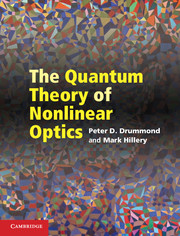Book contents
- Frontmatter
- Contents
- Preface
- Introduction
- 1 Classical nonlinear optics
- 2 Field quantization
- 3 Quantized fields in dielectric media
- 4 Microscopic description of media
- 5 Coherence and quantum dynamics in simple systems
- 6 Decoherence and reservoirs
- 7 Phase-space distributions
- 8 Single-mode devices
- 9 Degenerate parametric oscillator
- 10 Quantum field dynamics
- 11 Quantum propagation in fibers and waveguides
- 12 Quantum information
- List of symbols
- Index
- References
11 - Quantum propagation in fibers and waveguides
Published online by Cambridge University Press: 05 May 2014
- Frontmatter
- Contents
- Preface
- Introduction
- 1 Classical nonlinear optics
- 2 Field quantization
- 3 Quantized fields in dielectric media
- 4 Microscopic description of media
- 5 Coherence and quantum dynamics in simple systems
- 6 Decoherence and reservoirs
- 7 Phase-space distributions
- 8 Single-mode devices
- 9 Degenerate parametric oscillator
- 10 Quantum field dynamics
- 11 Quantum propagation in fibers and waveguides
- 12 Quantum information
- List of symbols
- Index
- References
Summary
Optical fibers are the backbone of the world's communication systems. They also represent the simplest example of a photonic device, where photons in waveguides replace electrons in wires. More sophisticated devices than this can be made, in which all the optical components – including multiple waveguided modes – are integrated on a chip. It is important to understand the quantum noise properties of these systems.
While in some respects these systems can be treated as one-dimensional, there are additional features. Dispersion is due not just to material properties, but also to the waveguide geometry. The nonlinearity comes from a combination of material and geometric properties as well. There is, of course, a quantum aspect to these photonic devices, in which quantum noise occurs due to random effects caused by nonlinearity and gain.
Optical devices based on waveguides are, of course, not just simple fibers. One can have multiple waveguides with various types of linear coupling. The intrinsic nonlinearity of the dielectric leads to four-wave mixing, which can be an important source of correlated photons, both for fundamental tests of quantum mechanics, and for applications in quantum information.
It is often essential to include effects due to anisotropies of various types, as well as material dispersion. In dielectrics, another effect that should be included is the coupling of vibrational modes of the (solid) dielectric to the propagating field, which gives rise to Raman and Brillouin scattering effects. This allows us to obtain a more detailed and correct theory of quantum noise than the simplified case treated in Chapter 3.
- Type
- Chapter
- Information
- The Quantum Theory of Nonlinear Optics , pp. 319 - 345Publisher: Cambridge University PressPrint publication year: 2014

